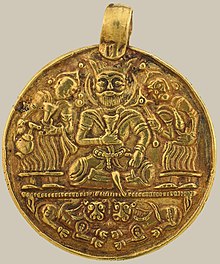
Back عضد الدولة Arabic عضد الدوله ARZ عضدالدوله دیلمی AZB Àdud-ad-Dawla Catalan Adud ad-Daula German Adud al-Dawla Spanish عضدالدوله دیلمی Persian Adhud ad-Dawla Fanna Khusraw French עצ'ד אל-דולה HE Adud ad-Daula Hungarian
| Adud al-Dawla | |
|---|---|
| Amir al-Umara[a] King of Kings[b] | |
 Medallion of Adud al-Dawla | |
| Emir of Fars | |
| Reign | 949–983 |
| Predecessor | Imad al-Dawla |
| Successor | Sharaf al-Dawla |
| Emir of Kerman | |
| Reign | 967–983 |
| Predecessor | Mu'izz al-Dawla |
| Successor | Sharaf al-Dawla |
| Emir of Iraq and Jazira | |
| Reign | 978–983 |
| Predecessor | Izz al-Dawla |
| Successor | Samsam al-Dawla |
| Born | 24 September 936 Isfahan |
| Died | 26 March 983 Baghdad |
| Burial | |
| Consort | Sayyida bint Siyahgil |
| Issue | Sharaf al-Dawla Samsam al-Dawla Baha' al-Dawla Shahnaz Bint Fanna[c] |
| House | Buyid |
| Father | Rukn al-Dawla |
| Mother | Noblewoman of Firuzanids[d] |
| Religion | Shia Islam |
Fannā (Panāh) Khusraw (Persian: پناه خسرو), better known by his laqab of ʿAḍud al-Dawla (Arabic: عضد الدولة, lit. 'pillar of the [Abbasid] dynasty'; 24 September 936 – 26 March 983) was an emir of the Buyid dynasty, ruling from 949 to 983, and at his height of power ruling an empire stretching from Makran to Yemen and the shores of the Mediterranean Sea. He is widely regarded as the greatest monarch of the dynasty, and by the end of his reign he was the most powerful ruler in the Middle East.[2]
The son of Rukn al-Dawla, Fanna Khusraw was given the title of Adud al-Dawla by the Abbasid caliph in 948 when he was made emir of Fars after the death of his childless uncle Imad al-Dawla, after which Rukn al-Dawla became the senior emir of the Buyids. In 974 Adud al-Dawla was sent by his father to save his cousin Izz al-Dawla from a rebellion. After defeating the rebel forces, he claimed the emirate of Iraq for himself, and forced his cousin to abdicate. His father, however, became angered by this decision and restored Izz al-Dawla. After the death of Adud al-Dawla's father, his cousin rebelled against him, but was defeated. Adud al-Dawla became afterwards the sole ruler of the Buyid dynasty and assumed the ancient Iranian title of Shahanshah ("King of Kings").[3][4]
When Adud al-Dawla became emir of Iraq, the capital city, Baghdad, was suffering from violence and instability owing to sectarian conflict. In order to bring peace and stability to the city, he ordered the banning of public demonstrations and polemics. At the same time, he patronized a number of Shia scholars such as al-Mufid, and sponsored the renovation of a number of important Shia shrines.
In addition, 'Adud al-Dawla is credited with sponsoring and patronizing other scientific projects during his time. An observatory was built by his orders in Isfahan where Azophi worked. Al-Muqaddasi also reports that he ordered the construction of a great dam between Shiraz and Istakhr in 960. The dam irrigated some 300 villages in Fars province and became known as Band-e Amir (Dam of the Emir). Among his other major constructions was the digging of the Haffar channel, that joined the Karun river to the Shatt al-Arab river (the confluence of the Tigris and the Euphrates). The port of Khorramshahr was built on the Haffar, at its junction with the Shatt al-Arab.
- ^ Busse 2004, p. 52.
- ^ Bürgel & Mottahedeh 1988, pp. 265–269.
- ^ Clawson & Rubin 2005, p. 19.
- ^ Bosworth 1975, p. 275.
Cite error: There are <ref group=lower-alpha> tags or {{efn}} templates on this page, but the references will not show without a {{reflist|group=lower-alpha}} template or {{notelist}} template (see the help page).